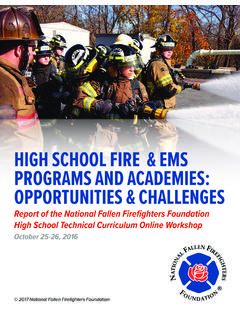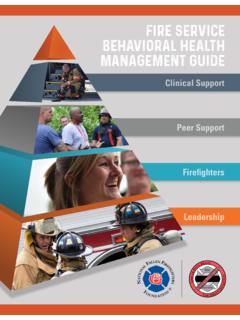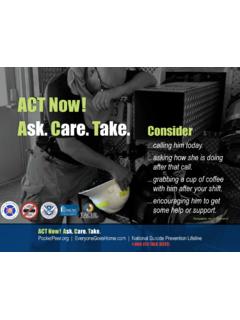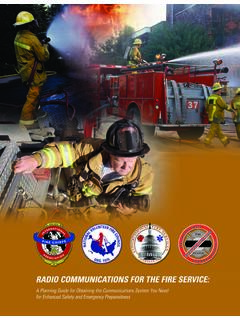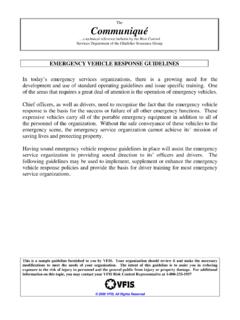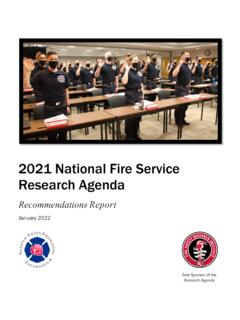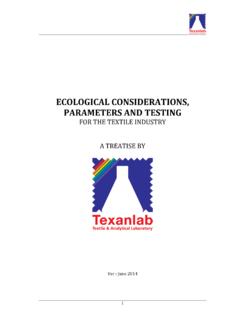Transcription of Fire Service Occupational Cancer Alliance - …
1 fire Service Occupational Cancer Alliance Proceedings from January 2015 April 2016 June 2016 The National Fallen Firefighters Foundation | fire Service Occupational Cancer Alliance ii Introduction Dear fire Service Professional, In the following pages, you will read a summary of the work to date of the fire Service Occupational Cancer Alliance , as well as a full report of the October 2015 meeting. In the Alliance s brief history just over a year much has been accomplished by Alliance participants and others. The fire Service has achieved several notable milestones in addressing Cancer including reauthorization of the Zadroga Act, and legislation that has been introduced to develop a registry for firefighter cancers.
2 The Alliance is unified and prepared to rally behind the KNOW Firefighter Cancer tagline. But, much more needs to be done. Consider this. At our first meeting, I asked how many in the audience knew a firefighter who has or had Cancer . Virtually everyone raised their hand. I then asked how many in the room were Cancer survivors themselves. It was amazing how many hands went up in response to that question as well. Two years ago, in March 2014, the National Fallen Firefighters Foundation hosted the 2014 Firefighter Life Safety Summit. This Summit, known as TAMPA2, provided numerous recommendations focusing on reducing firefighter injuries and deaths. One of the prevailing suggestions made by participants was the need to focus greater attention on firefighter Occupational illnesses and diseases.
3 Up until that point, a few organizations had been working to draw attention to the issue of Cancer within the fire Service , and to take actions to reduce firefighter exposures to carcinogens but there was not a unified strategy to address the problem as an industry. In January 2015, as a follow-up to TAMPA2, the National Fallen Firefighters Foundation invited major fire Service organizations and Occupational Cancer -specific researchers to attend an Occupational Cancer in the fire Service Strategy Meeting in Washington The goals of the meeting were to review what was known related to firefighter cancers, develop a coordinated effort to reduce exposures, illnesses, and deaths related to Cancer , and provide support for those affected by Cancer .
4 Through presentations, breakout group discussions, and a goal of consensus, the group developed 12 recommendations to target their efforts. In May 2015, a Steering Committee comprised of a cross section of fire Service leaders and researchers who attended the January 2015 meeting convened in Phoenix, Arizona. They were tasked with developing action steps for the objectives outlined at the previous meeting. At that meeting, it recommended that the group be called the fire Service Occupational Cancer Alliance . The Steering Committee also asked that the larger group reconvene as soon as possible, to complete development of the Action Plan begun in May. Figure 1. 2016 CFSI Dinner Challenge Coin The National Fallen Firefighters Foundation | fire Service Occupational Cancer Alliance iii The next meeting of the Alliance was held in October 2015, in Arlington, Virginia.
5 The Steering Committee reported their work to the group, and sought input on critical issues related to their recommendations. Now, with the completed plan of action, the Alliance is positioned to move forward in our battle with this insidious disease. Armed with the input provided in 2015, the Alliance will ask that organizations and individuals within the fire Service agree to work as partners, embracing common goals to reduce the impact of Occupational cancers in the fire Service . My greatest wish is that someday in the future, when a room of firefighters are asked how many have been or are battling Cancer , very few hands are raised. Chief Dennis Compton Chair, Board of Directors National Fallen Firefighters Foundation A Call for Collaboration Action to prevent firefighter Occupational Cancer and support those that have Cancer must be a collaborative effort involving all parts of the fire department and affiliated organizations.
6 The efforts of everyone need to be coordinated for us to be effective in this fight. In career fire departments, management and the union must be on the same page. In volunteer and combination fire departments, chief officers, first district or fire department leadership, and firefighters and company officers need to be together. Some departments have unions or member organizations that need to be part of the solution as well. In the wildland community, where firefighters and fire officers may be full-time or seasonal, it s especially important for leadership to work with employee organizations to seek ways to prevent exposure and keep track of the health of all firefighters. Our best chance of beating Cancer is to work together.
7 The National Fallen Firefighters Foundation | fire Service Occupational Cancer Alliance iv Contents INTRODUCTION .. II Occupational Cancer IN THE fire Service STRATEGY MEETING (JANUARY 2015) .. 1 FSOCA STEERING COMMITTEE MEETING (MAY 2015) .. 3 fire Service Occupational Cancer Alliance MEETING (OCTOBER 2015) .. 5 NATIONAL fire Service RESEARCH AGENDA SYMPOSIUM (NOVEMBER 2015) .. 17 ADDITIONAL MILESTONES .. 20 FSOCA STEERING COMMITTEE MEETING (APRIL 2016).. 21 ACTION PLAN STATUS UPDATE APRIL 2016 .. 21 APPENDIX A: ATTENDEES AT THE OCTOBER 2015 FSOCA MEETING .. 32 APPENDIX B: ATTENDEES AT THE APRIL 2016 FSOCA STEERING COMMITTEE MEETING .. 34 APPENDIX C: CFSI RESOLUTION IN SUPPORT OF THE JAMES ZADROGA 9/11 HEALTH AND COMPENSATION REAUTHORIZATION ACT.
8 35 APPENDIX D: CFSI RESOLUTION IN SUPPORT OF FEDERAL LEGISLATION, FUNDING, AND POLICIES TO ADDRESS FIREFIGHTER Occupational Cancer .. 36 APPENDIX E: PROPOSAL FROM CHIEF DENNIS COMPTON FOR THE 2016 CFSI SEMINAR .. 37 APPENDIX F: RESOURCES .. 38 NFFF MISSION .. 41 The National Fallen Firefighters Foundation | fire Service Occupational Cancer Alliance 1 Occupational Cancer in the fire Service Strategy Meeting (January 2015) fire Service leaders, physicians, government officials, and scientists met on January 14-15, 2015 in Washington, for the Occupational Cancer in the fire Service Strategy Meeting. The meeting was coordinated by the National Fallen Firefighters Foundation (NFFF) and chaired by Chief Dennis Compton, Chair of the Board of Directors of the NFFF.
9 This initial meeting brought together fire Service leaders, representatives of the major fire Service constituency organizations, and researchers to develop a unified strategy for addressing a growing issue in the industry. During this meeting, presentations, group discussions, and breakout session discussions were geared toward addressing the stated objectives of the meeting: 1. Learn what science can tell us about Cancer in firefighters. 2. Identify what we think we know, but needs further research. 3. Review what has been done, and what needs to be done. 4. Address whether or not anyone is being left behind on the issue of firefighter Cancer are there specific populations who are not being studied or have been left out of the discussion?
10 5. Identify what organizations and corporate entities can be counted on as partners. 6. Discuss the Zadroga Act and its implications at the national, state, and local levels. 7. Review model state presumptive laws and strategies to push legislation in every state, including implications on workers compensation and pension systems. 8. Discuss implications on the Line-of-Duty Death criteria, including those on workers compensation and death benefits. Presentations on the findings of recent firefighter Cancer research included a study of World Trade Center firefighters, the challenges of firefighter Occupational exposure research, future research needs, actions that can be taken to reduce the risk of Cancer , and an update on state presumptive laws and the Zadroga Act.

